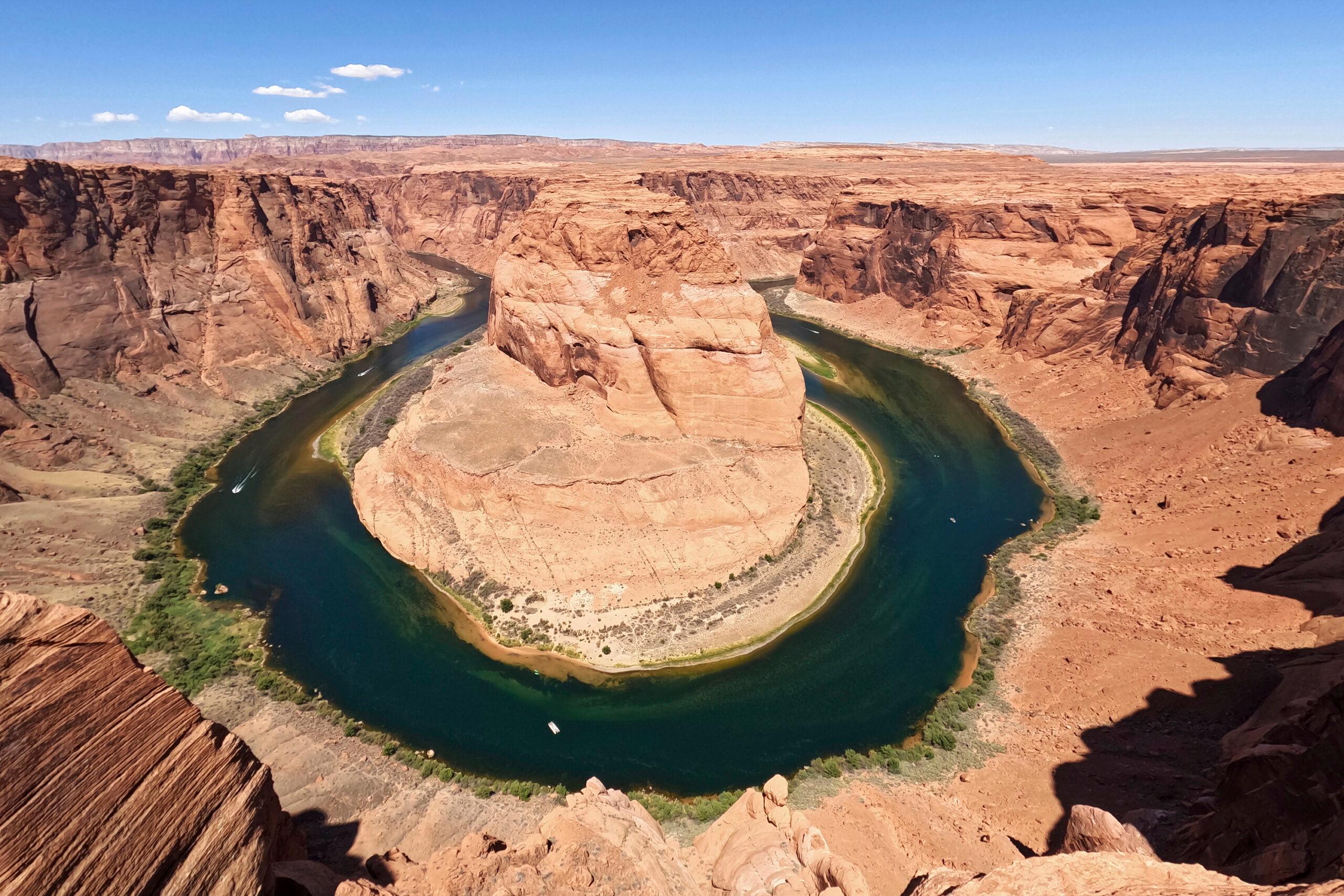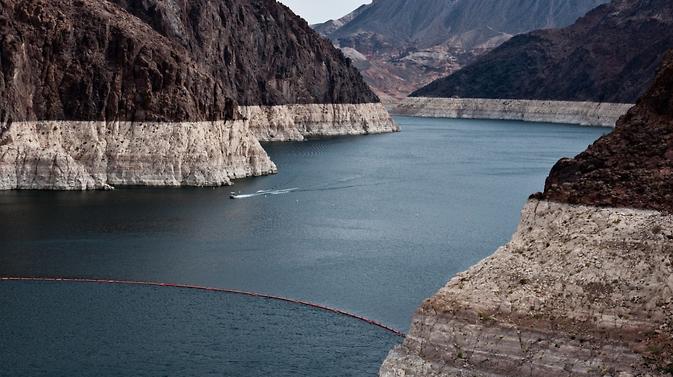
One month after states missed a federal deadline to propose ways to drastically cut their use of water supplied by the Colorado River, water managers who met for a seminar in Grand Junction said they still didn’t have comprehensive solutions ready to help bolster the imperiled river system.
Water leaders, agricultural producers, environmentalists and others from across the drought-stricken river basin met Friday for the Colorado River District’s annual water seminar to discuss the historic-low levels in the river’s biggest reservoirs — and the need to cut back usage from Wyoming to California.
While the problems the basin faces were apparent in the day-long discussions about the state of the river, solutions were not.
The event’s host, Colorado River District General Manager Andy Mueller, told attendees that scientists now recommend that water managers plan for the river to provide just 9 million acre-feet of water annually. That’s a reduction of about a quarter from the amount used in 2021 by U.S. states, Native American tribes and Mexico.
The Colorado River system supplies nearly 40 million people across the West with drinking water and irrigates around 5 million acres of farmland. People are taking too much water out of the system, and prolonged drought fueled by climate change has sapped the river’s supplies.
“That’s incredibly scary,” Mueller said of the prospect of cutting planned usage to a collective 9 million acre-feet. “That’s huge economic disruption. That’s communities suffering in all the basins.”
In an interview, Mueller said the Friday seminar was held to educate attendees on the seriousness of the Colorado River situation. Still unanswered is what the states and tribes represented in the room will do to drastically curtail use.
While the representatives for the governments agreed that solutions need to be collaborative, no one offered to be the first to make big cuts. However, representatives from nearly every state stressed that they have already cut back on the amount of water they're legally allowed to use.
“I think the honest answer is right now there is no plan,” J.B. Hamby of the Imperial Irrigation District in California said in response to a question from the audience about how significant cutbacks would be achieved.
The Imperial district’s farms use millions of acre-feet of water a year to produce massive portions of the national food system. Hamby said water managers along the Colorado River have been distracted by incremental “dumpster fires,” and are not adequately focusing on the need for a new long-term plan that accounts for reduced water in the river.
The theme of this year’s Colorado River District annual seminar was “Overdrawn”
The theme refers to the emergency status of the Colorado River and its biggest reservoirs: Lake Powell and Lake Mead. Mead, on the border of Nevada and Arizona, has dropped so low that there’s fear that turbines at Hoover Dam won’t have enough water to keep spinning and generating hydroelectric power for millions of people.
If the reservoir keeps plummeting, the infrastructure that delivers water to cities and farms in Nevada, Arizona and California is also at risk of failing.

In June, the commissioner of the U.S. Bureau of Reclamation gave water managers in the Colorado River Basin states 60 days to create an emergency plan to stop using between 2 and 4 million acre-feet of water in the next year — roughly one-fifth of the water currently allocated to states.
No basin-wide plan to make those cuts — or to go further and use just 9 million total acre-feet as advised by many scientists — has been produced so far.
The Colorado River basin is divided into two parts: the states and tribes upstream of Lake Powell include Colorado, Wyoming, Utah and New Mexico; downstream users include Arizona, California and Nevada. The upstream states have proposed a plan on how they might be able to keep more water in the river, but it doesn’t include any mandatory water cuts.
Throughout the seminar sessions Friday, upper-basin managers said lower-basin states need to take the lead in the water savings. Asked why the upper basin wouldn’t put out a plan first to get the entire river system closer to a solution, Mueller with the Colorado River Water Conservation District said in the interview with CPR News that the state of Colorado is working on specific conservation plans but doesn’t intend to release them until the lower-basin states act.
“If we start reducing water right now, it will alleviate the pressure on the lower basin and the Bureau of Reclamation,” Mueller said. “The idea that our water users and communities would suffer the economic harm associated with reducing water use, only to continue to feed that lower basin addiction, is untenable from our perspective.”
Meanwhile, lower-basin water managers attending the Friday conference stressed the water savings they have made in the past and asked that states like Colorado stop waiting for the lower-basin to act.
“Any water user in this basin needs to be making a plan of how to use 20 to 30 percent less water,” said Patrick Dent from the Central Arizona Project, which supplies water to the Phoenix area, Tucson, and farms in Arizona, among others. The Central Arizona Project is one of the first to face mandatory cutbacks, so the state has an incentive to encourage others to act first.
- Colorado’s water future could look more like Arizona’s. That means a lot less snow and water for the Colorado River.
- A 150-year-old San Luis Valley farm stops growing food to save a shrinking water supply. It might be the first deal of its kind in the country
- Colorado’s water leader thinks most of the needed Colorado River cuts should be made by Arizona, Nevada and California
Thirty Indigenous tribes in the Colorado River basin collectively hold rights to 25 percent of the water supply
But the tribes haven’t been able to put all of that water to use due to a lack of infrastructure and funding, and a history of exclusion from water-sharing agreements. As states along the Colorado River discuss who will take the first big step towards significant conservation, tribes are making the point that they legally control much more water than they currently use. They want those rights recognized and to be compensated for them.
Colorado and other upper-basin states are holding meetings with tribes as they discuss how to realize major water savings along the river, but Daryl Vigil, the former water administrator for the Jicarilla Apache Nation, told attendees Friday there’s still no real mechanism for the tribes to participate in formal Colorado River discussions, so they are building that structure in the middle of the current water crisis.
“We want to speak on behalf of our own water. We’ve heard a whole lot about sacrifice and hurt and pain, and we know a whole lot about that,” he said. “We’re demanding participation.”
Lorelei Cloud, a member of the Southern Ute Indian Tribe’s Tribal Council, said if the states and federal government ignore or marginalize tribal nations — it will be at their own peril.
“Those 30 tribes, when they start putting their water to use, and they do plan on doing that, there will be nothing left for the rest of you — especially those of you that are using unused tribal water. And that unused tribal water is what’s being stored in Lake Powell and Lake Mead,” she said.
“And shame on all of us if we don’t leave [water] for our future generations to thrive in,” Cloud added from the stage at Colorado Mesa University, drawing some of the day’s biggest applause from the roughly 200 people in attendance.
One solution would take some pressure off of states and put it on federal officials
Colorado officials, backed up by representatives from Arizona and Utah, told seminar attendees they want to put more pressure on the federal government to account for the water that is lost when water moves from the two major reservoirs, Powell and Mead, to downstream states, especially California.
Mueller estimated that 1.2 million acre-feet of water are lost in evaporation and in transport. He wants the U.S. Bureau of Reclamation to force California and others to account for those losses. He also acknowledged that change alone would not achieve the level of cutbacks the people who rely on the Colorado River collectively need to make.









